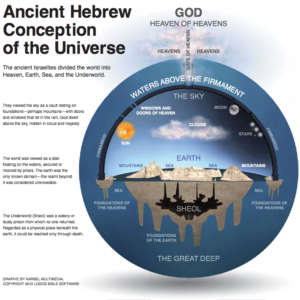
Some biblical scholars hold that Genesis 1 either used the Babylonian creation myth, the Enuma elish, or was generally dependent upon it and other Mesopotamian traditions. Drawing on the work of Alexander Heidel in Babylonian Genesis, we find both parallels and differences between the Enuma elish and Genesis 1. Ultimately Heidel felt that the differences were far too great and the similarities far too insignificant. “In my estimation, no incontrovertible evidence can for the present be produced for either side.” Poetically, he said: “the resemblances fade away almost like the stars before the sun.” However, some of the similarities are striking.
In the Enuma elish, we find a story of how the earth came to be. In the beginning there was only the divine parents—Apsu and Tiamat—and their son, Mummu (Remember, this was ancient Babylon. Maybe Mummu was a popular name back then). Apsu was the primeval sweet-water ocean and Tiamat was the primeval salt-water ocean. Mummu was the mist rising from the two bodies of water and hovering over them. When Apsu and Tiamat comingled their waters, they gave birth to Lahmu and Lahamu, two silt deposits who eventually formed land. The three types of water were mingled together, forming an undefined mass in which were all the elements from which the universe was later made. But as yet, there was no heaven or earth.
In time, Apsu and Tiamat had more children, Anshar and Kishar. Together they had a son named Anu, who was the sky-god. Anu’s son was Ea, who became the god of the subterranean sweet-waters, the god of magic and eventually the mastermind of all the divinities. “He had no rival among his fellow-gods.” The younger gods were noisy and loud, disturbing the older gods, Apsu and Tiamat. When peaceful attempts to quiet them failed, Apsu determined to destroy them. But Ea through the power of the spoken word of a magic spell put Apsu to sleep. He then took Apsu’s royal tiara and supernatural radiance for himself and killed Apsu, the father of all the gods. Ea then established a spacious place for himself and all the remaining gods to live, calling that place “Apsu.”
So far, there is no real parallel between the two accounts, but we now come to the time of Marduk the son of Ea and “the wisest of the gods.” Tiamat resented the death of her consort, and sought revenge against the other gods for killing Apsu. So she decided to revolt against the other gods, but was defeated in battle by Marduk. He divided her body in two forming the universe, “with one half he formed the sky, with the other he fashioned the earth.”
Next, he created stations in the sky for the great gods; he organized the calendar, by setting up stellar constellations to determine by their rising and setting the year, the months, and the days; he built gates in the east and in the west for the sun to enter and depart; in the very center of the sky he fixed the zenith; he caused the moon to shine and entrusted the night to her.
The story continues with a discussion of the further creation acts of Marduk. They have some similarity to the biblical account in Genesis as seen in this chart reproduced from the Babylonian Genesis. Note that in both accounts, light is created before the luminaries. But even in what follows, there is not complete correspondence. In fact, “the differences far outweigh the similarities.”
|
Enuma elish |
Genesis |
|
Divine spirit and cosmic matter are coexistent and coeternal |
The divine spirit creates cosmic matter and exists independently of it |
|
There is primeval chaos; Tiamat is enveloped in darkness |
The earth is a desolate waste, with darkness covering the deep. |
|
Light emanated from the gods
|
Light is created |
|
The creation of the firmament
|
The firmament is created |
|
The creation of dry land
|
Dry land is created |
|
The creation of the luminaries
|
The luminaries are created |
|
The creation of humanity
|
Humanity is created |
|
The gods rest and celebrate
|
God rests and sanctifies the seventh day |
If Genesis 1:1-2:3 really was influenced by Enuma elish, then it is reasonably certain that at least the following elements go back to the Babylonian epic: (1) part of the outline; (2) the conceptions of an immense primeval body of water containing the component parts of the earth; (3) the idea of the primeval waters; and (4) the existence of light before the luminaries.
There were also parallels with other Near Eastern cultures and their own creation stories as well. The Egyptians and the Phoenicians referred to a watery chaos in their cosmologies. There was primeval darkness within the cosmologies of the Greeks and the Phoenicians. However, in his commentary on Genesis 1-15, Gordon Wenham seems to capture the right view. He said the known links of the Hebrew patriarchs with Mesopotamia and the other areas of the Near East make it improbable that the writers of Genesis were completely ignorant of Babylonian and other similar creation stories.
Most likely they were conscious of a number of accounts of creation current in the Near East of their day, and Gen 1 is a deliberate statement of the Hebrew view of creation over against rival views. It is not merely a demythologization of oriental creation myths, whether Babylonian or Egyptian; rather it is a polemical repudiation of such myths.
Drawing on Scripture and Cosmology by Kyle Greenwood, Brad Kramer elaborated on the similarities between Hebrew and other Near Eastern cosmologies. The people of the biblical world assumed that rather than what we think of as “outer space”, there was a universally-wide cosmic ocean. For them this was an entirely rational belief based upon everyday observation and intuition. Why was the sky blue? Where did rain come from? “Ancient people figured that the sky was blue because there was a giant cosmic ocean high above the earth.” And rain came in through the windows and doors of a heavenly dome.
It was a nearly universal belief in biblical times that the sky was a solid structure, serving as a barrier for the upper waters. Aligned with the common experience of finding water deep in the ground, “The ancients conceived of the earth arising out of primordial waters, called the cosmic ocean…the earth was thought to be surrounded by these cosmic waters.” So the ancient Hebrew understanding of the universe looked something like the following:
Biblical evidence for this ancient cosmology exists within Genesis 1 itself. Genesis 1:6 through 9, covering the second day and part of the third day of creation, described how God created an expanse or firmament (rāqîaʿ) in the midst of the waters. This firmament separated the waters above and below. This firmament was thought to be a beaten metal plate or bow; a gigantic heavenly dome. Kramer concluded:
These verses only make sense if the whole universe is filled with water. The picture here is God blowing a bubble of habitable space in the middle of the cosmic sea and placing a barrier to keep the waters from crashing down onto earth. Interestingly, the heavenly bodies (sun, moon, and stars) are “set…in the dome” (1:17), under the “waters above”, rather than above them. So again, the picture is of cosmic waters encircling the entire universe, including stars and planets (which ancients assumed were attached to the solid dome). Greenwood concludes: “As was the case with ancient Israel’s neighbors, the land mass they called earth was thought to be surrounded by water—east and west, above and below.”
Further Biblical evidence that the Hebrews seemed to have a three-tiered cosmology of the universe, with the earth situated in the middle between the heaven above and the deep beneath can be found in passages such as: Genesis 49:25, Deuteronomy 33:13, and Psalm 135:6. This three-tiered cosmology continued even into the early days of the church. To give but one example, in The Literal Meaning of Genesis, which Augustine wrote in 416 AD, he discussed why he thought the “star” Saturn was actually cold and not hot, as others speculated.
Indubitably, therefore, what makes it cold is the nearness of those waters set in places above the heavens, which these people refuse to believe who argue in the way I have summarized about the movement of the sky and the constellations. It is by drawing such inferences that some of our people meet those who refuse to believe there are any waters above the heavens and still insist on the coldness of that star whose circuit is nearest to the highest heaven.
For Christians with a modern scientific worldview such a cosmology is nonsensical. So they tend to import (sometimes unconsciously) the criteria of modern scientific accuracy into their reading of Genesis 1. This adds an “artificial middleman” to its interpretation. Attempting to combine an ancient cosmology with a modern scientific one will ultimately render both incoherent or out of focus at some point. And if we are attempting to convince a modern, science-minded person of the truth and authority of the Bible, “Do we really want an apologetic in which the truth of the Bible depends on the accuracy of scientific beliefs of ancient cultures?”
For more articles on creation in the Bible, see the link “Genesis & Creation.”






